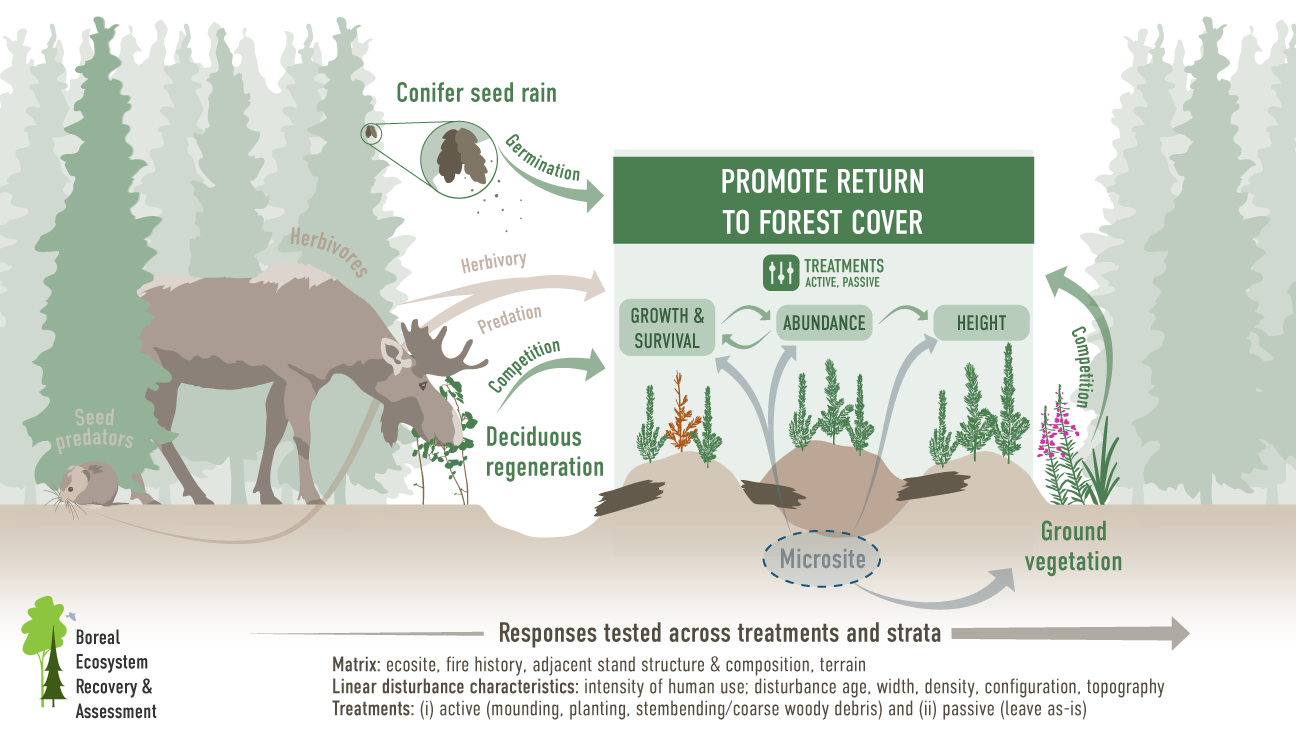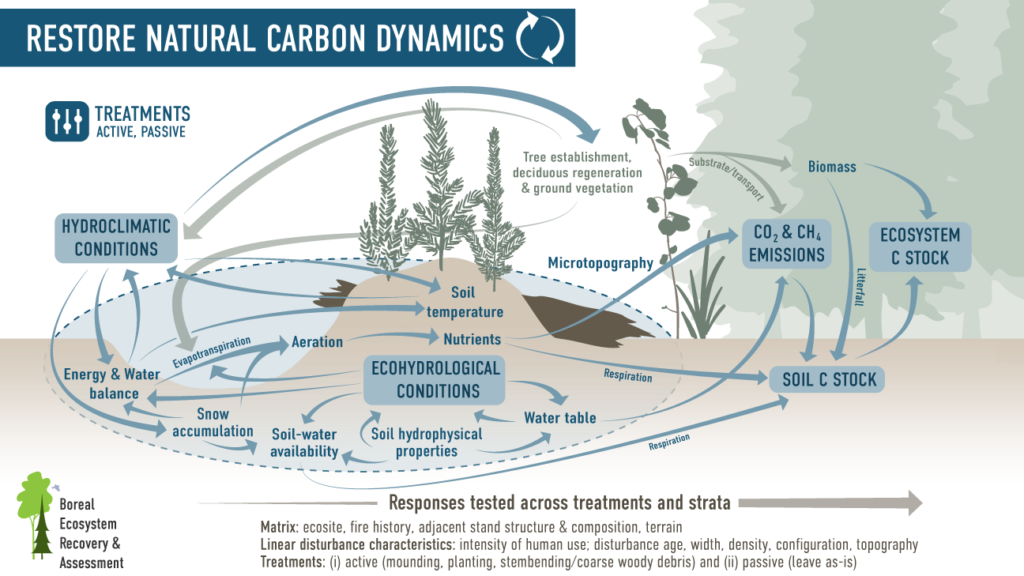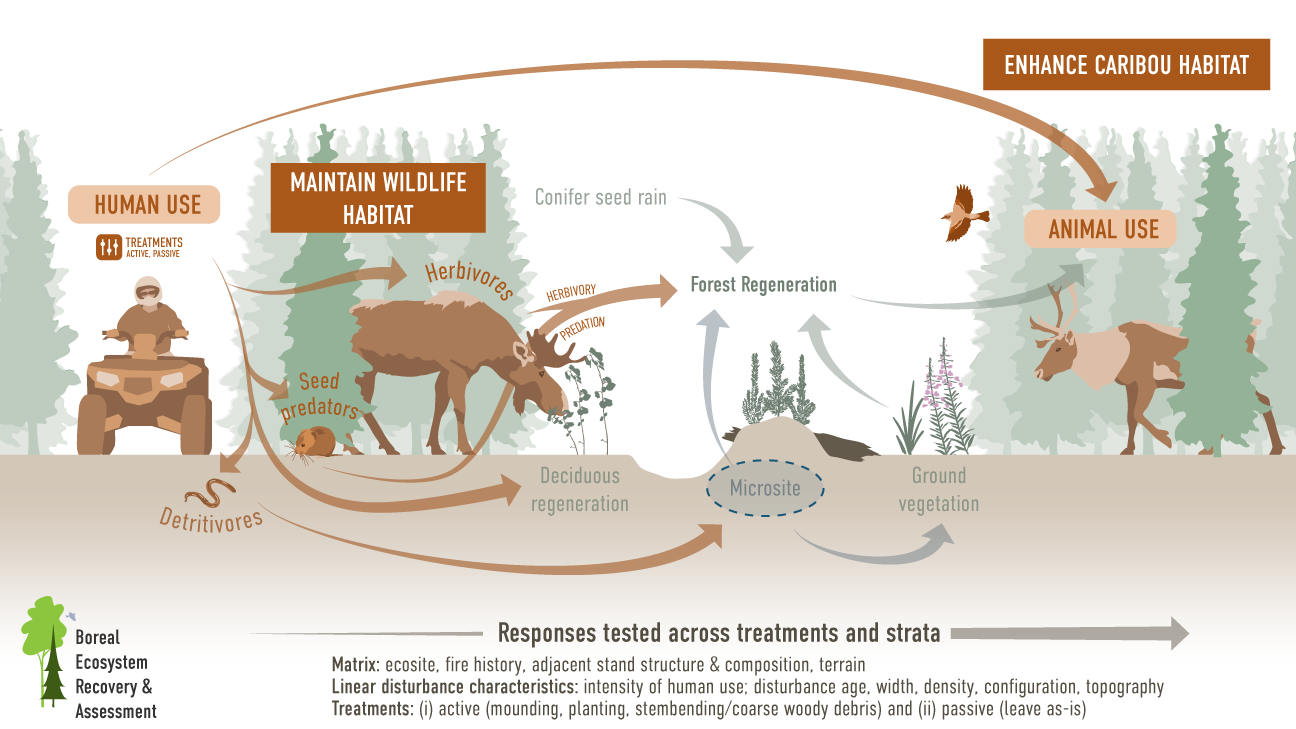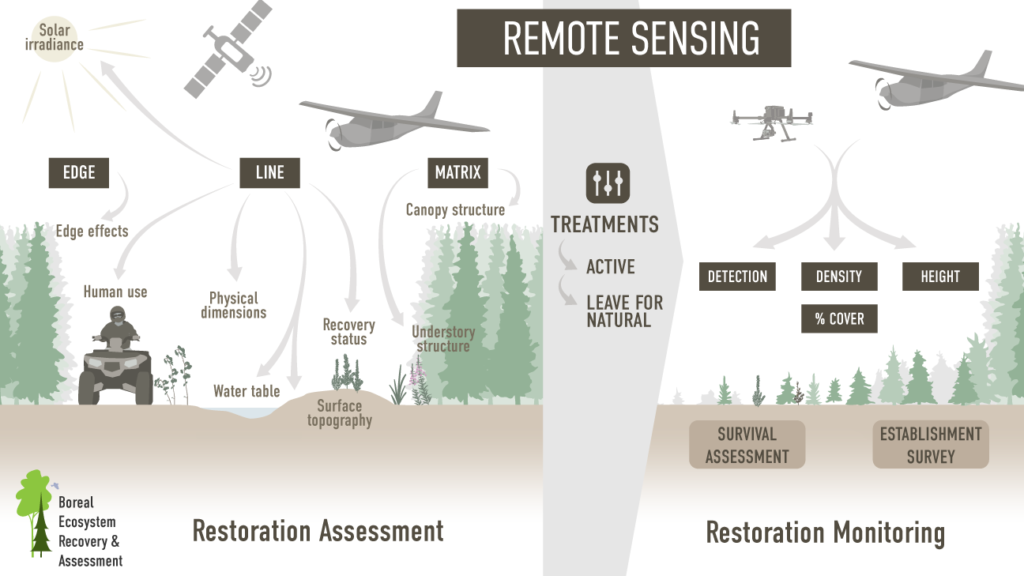There are four themes within BERA: Vegetation, Soils and Ecohydrology, Humans and Wildlife, and Remote Sensing. Each theme addresses one or two strategic priorities that are coupled with one or more tactical deliverables. These tactical deliverables are the specific targets for BERA’s models and planning tools.
Each theme dives deeper into the complex systems (below) that give rise to our specific list of associated projects .
Theme 1: Promote a Return to Forest Cover
Oil sands exploration results in early seral vegetation of the exploratory disturbances (seismic lines, exploratory well pads) that form openings in the forest where ground vegetation (particularly graminoids and shrubs) and the simplification of microtopography and compaction of soils (microsites for tree establishment) can restrict forest recovery rates resulting in arrested succession at some sites. This is particularly true for treed peatlands where microtopography and water levels are especially important in controlling tree recruitment and growth. Shrubs in these disturbances (browse subsidy) may also promote herbivory by moose and deer of the shrubs, but also of young trees. Likewise, the ground vegetation can increase seed predators that may further restrict tree establishment, or more generally result in increases in competition with tree seedlings affecting their survival and growth. For some species, such as spruce and pine, patterns in seed rain vary by age of forests, presence of fire (serotiny), and natural trends in masting (cone/seed production) between years that can affect patterns in conifer tree recruitment. Deciduous species may be recruited by seed, but often rely on vegetative resprouting and thus may be less sensitive to the disturbance and eventually more represented in tree recovery on disturbances. Modification in the microsites through restoration treatments may address the microsite conditions that promote natural recruitment of trees (exposed mineral soil, above flooding/water table in peatlands, etc.) or represent places for tree planting. This diagram represents these drivers on the key restoration responses of tree abundance, tree heights, and the growth rates of those trees. Matrix conditions (stand type, fire history, etc.) all affect these patterns, as well as characteristics of the oil sands disturbances themselves (age, size, intensity of past use, etc.). The BERA project aims to measure these responses and drivers to better understand factors that facilitate or prohibit recovery of forest cover on oil sands disturbances, particularly seismic lines.
Theme 2: Restore Natural Carbon Dynamics
Ecosystem carbon dynamics are largely driven by productivity of the plant community and organic matter decomposition in soils mediated by soil fauna and the microbial community. Tree establishment and growth makes an important contribution to carbon uptake and biomass production but the ground layer plants also play an important role in boreal ecosystems, particularly in lowland ecosites. Competition with the ground layer vegetation is likely important for tree seedling establishment. Carbon is added to the soil as organic matter by roots and litterfall where its decomposition is controlled by soil temperature and aeration. Soil properties largely control water retention, and thus aeration, which impacts carbon cycling. Soil moisture content and water table position are also predictors of methane emissions. Organic matter turnover also contributes to nutrient availability; this, along with soil aeration play a role in tree establishment and the composition of the vegetation community. Seismic line disturbances are known to result in near-surface soil compaction and surface depression causing higher soil moisture content and shifts in the plant community, conditions that contribute to slow regeneration of the forest cover. Treatments, such as mounding, create microtopography that improve soil aeration for trees, but will also alter soil carbon cycling. In BERA, we aim to quantify these changes and inform best practices for the recovery of natural carbon dynamics.
Theme 3: Humans and Wildlife
The boreal forest is often described as “one of the largest intact ecosystems” on earth. As such, it is critically important to various species of wildlife. However, whether the boreal truly is “intact” depends fundamentally on how we perceive energy sector impacts as a disturbance. Narrow linear features and reclaimed well sites are the most extensive forms of energy disturbance, that if perceived as gaps and/or edges mean that the boreal forest is far from intact in Alberta. Thus, understanding how wildlife behave on or near linear features, whether this has population consequences for forest specialists, and if non-native or generalist species are colonizing the system and thereby alter the community are fundamental questions. Determining how width, density, vegetation state, and human use on energy sector disturbances are pivotal for evaluating the claim of boreal intactness and is the core of our program.
Theme 4: Remote Sensing
The remote-sensing team develops workflows and planning tools designed to assist management and research activities associated with (i) restoration assessment and (ii) restoration monitoring. Where possible, we try to detect, map, and attribute features directly. In these situations, our research questions are generally under what conditions (technical, environmental) can remote sensing effectively deliver the required information? In cases where the features of interest cannot be measured directly, we develop remote-sensing analogs (metrics or indices extracted from spectral, structural, or temporal data sets) and assess the extent to which these remote-sensing traits are related to the processes or attributes of interest. The Remote Sensing diagram illustrates some of our high-priority targets.



